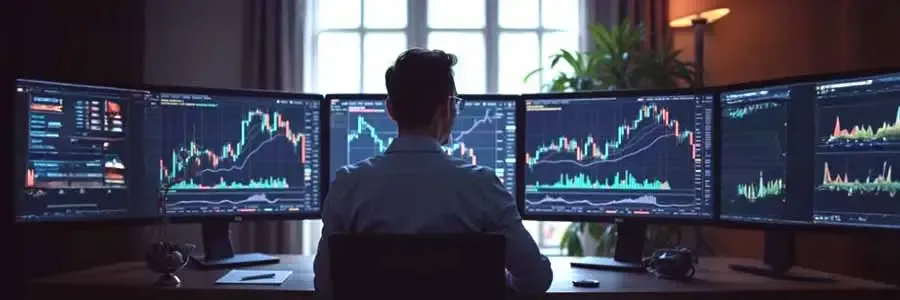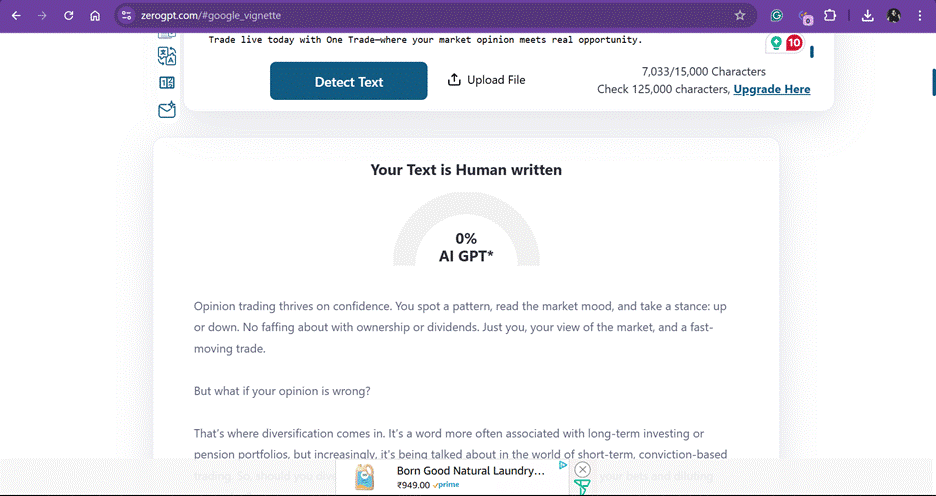
July 09, 2025
Opinion trading thrives on confidence. You spot a pattern, read the market mood, and take a stance: up or down. No faffing about with ownership or dividends. Just you, your view of the market, and a fast-moving trade.
But what if your opinion is wrong?
That’s where diversification comes in. It’s a word more often associated with long-term investing or pension portfolios, but increasingly, it's being talked about in the world of short-term, conviction-based trading. So, should you diversify when opinion trading? Or is that just hedging your bets and diluting your edge?
Let’s unpack it properly, with some clear examples, practical tips, and a look at how to balance sharp instincts with smart structure.
What exactly is opinion trading?
Before diving into diversification, let’s quickly get on the same page. Opinion trading is all about placing a trade based on a simple directional view. You don’t buy the asset itself—you predict where its price is heading and take a position on that basis.
Platforms like One Trade have made this process refreshingly simple.
But when the trade is that focused, does diversification still matter?
Yes!
Let’s be honest to ourselves, for a lot of us trading is about making money mainly. And losing less of it when things don’t go to plan (that could happen to anyone). That’s exactly where diversification matters.
It doesn’t mean you’re not sure. It doesn’t mean you’re playing it safe. It means you're managing risk smartly.
Here’s why it works.
1. Less risk, same conviction
You might have a strong view that the euro’s going to rise. Great. But do you need to put all your capital on EUR/USD?
You could, of course. Or you could express that same view through a few different trades.
Will EUR/USD close higher over the next week?
Will EUR/JPY rise today?
Will USD/CHF fall this afternoon?
Each of those trades leans on a similar opinion, but with slightly different angles. If something strange happens to the pound or Swiss franc, you’re not wiped out. Diversification, in this case, doesn’t water down your view—it gives it more power.
2. More ways to win
Some traders make the same call across five assets. That’s not reckless—it’s strategic. If your opinion is based on a broader market theme, there might be several opportunities to act on it.
Take this example. You think inflation is cooling in the US:
Will the Nasdaq 100 rise in the next 4 hours?
Will gold increase by the end of the day?
Will USD/JPY fall this session?
Will AUD/USD climb during the New York session?
You’ve now taken one opinion and turned it into a small but mighty trading cluster. Any one of them could play out, and if a couple hit together, you’ve got a good return.
3. Keeps emotions in check
We all know trading can be a head game. When all your risk is in one trade, your emotional state is pinned to every tick. That can lead to poor decisions—cutting winners short, letting losers run, or panicking when the market moves sideways.
With a few trades running in parallel, especially if they’re balanced or uncorrelated, you give yourself the gift of perspective. Sticking to your plan is easier when you’re not all-in on one call.
So now the question is: how to diversify right?
Let’s be clear: you don’t need 20 trades running at once to diversify. In fact, that’s more likely to cause confusion. Good diversification in opinion trading means being thoughtful about what trades you place, how they interact, and how much they expose you to.
Here are some simple but powerful ways to do it.
A. Use themes
Build your trades around a central idea. If you think central banks are done hiking rates, you can:
* Buy FTSE 100 (cheaper borrowing helps business)
* Buy gold (traditionally loves rate pauses)
* Buy EUR/USD (euro gaining on dollar weakness)
You’ve not lost your focus—you’ve just given it depth. And that gives your trades more resilience.
B. Mix timeframes
Even in the fast world of opinion trading, not all trades have to be short-term. Combine quick in-and-out scalps with slightly longer swing trades. That way, if your short-term trade gets shaken out by noise, your broader view might still come good.
Most modern trading platforms, including One Trade, allow you to define your own expiry times. That makes mixing durations easy and effective.
C. Balance direction
Here’s a clever one: even if you’re bullish overall, include one or two trades that would benefit if things go the other way.
For instance, you’re generally optimistic about equities this week, so you go long on the S\&P 500 and Nasdaq. But you also short a single high-beta stock you think looks overbought. If there’s a wobble in the market, that short could soften the blow.
This isn’t hedging—it’s tactical balance.
D. Watch your correlations
Some assets move almost in lockstep. If you’re long on the Nasdaq, S\&P 500 and Dow Jones, that’s not really diversification. It's three versions of the same bet.
Instead, aim for trades that have some independence from each other. Long oil and short tech? That might give you a more varied profile, especially if inflation headlines drive the narrative.
But, there could be a time when diversification doesn’t help.
It’s not all upside. Let’s cover when diversification becomes a distraction.
A. Trading too many ideas
If you place five trades and none of them are connected by a common opinion or theme, ask yourself: are you really opinion trading, or just punting?
Having too many unrelated trades can muddy your thinking. It’s better to stay focused on a few well-thought-out views than to scatter capital across random plays.
B. Overlapping trades
It’s easy to think you’re diversified when you're not. Long EUR/USD and long GBP/USD? Both are bets against the US dollar. If the dollar rallies, both trades lose.
Make sure you understand how your positions are linked. Sometimes, fewer trades with clear differentiation give you more real diversification than a bigger, overlapping list.
C. Small accounts, big ambition
If you’re trading with a modest account size, diversifying too much can be counterproductive. Five trades with tiny risk each may not justify the time, effort, or platform fees.
Focus instead on quality. One or two solid opinion trades, placed with care, often beat a flurry of tiny punts.
Final Thoughts
So, should you diversify when opinion trading?
Yes—if you want to stay in the game longer, manage your risk smarter, and give your views a better chance of working out. Diversification in this context isn’t about playing it safe. It’s about playing it well.
The key is doing it with purpose. Diversify around themes. Use different instruments. Think across timeframes. But stay focused. Opinion trading is, after all, about backing your belief. Just make sure it’s built to withstand the occasional curveball.
Ready to apply this strategy? You don’t need a complicated setup or deep-pocketed account. All you need is a view, a plan, and the right platform.
Trade live today with One Trade—where your market opinion meets real opportunity.
